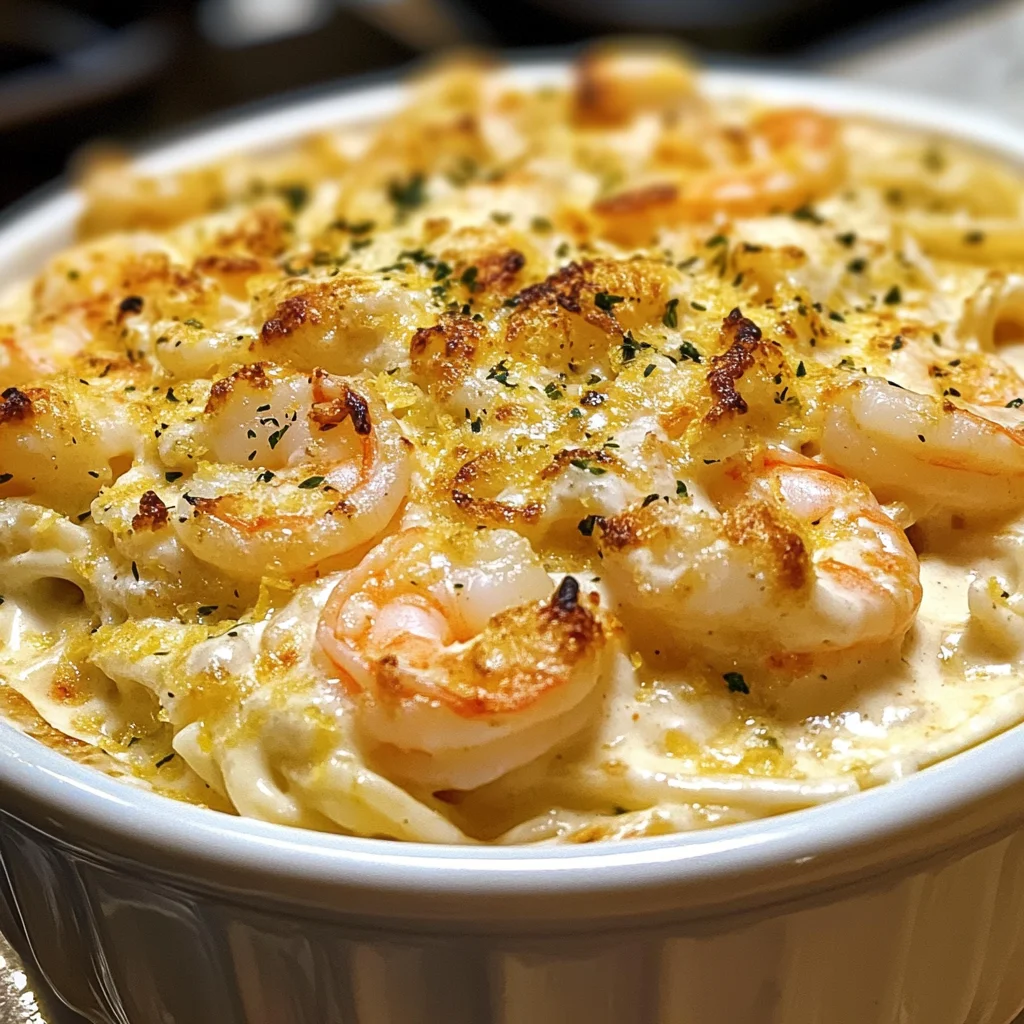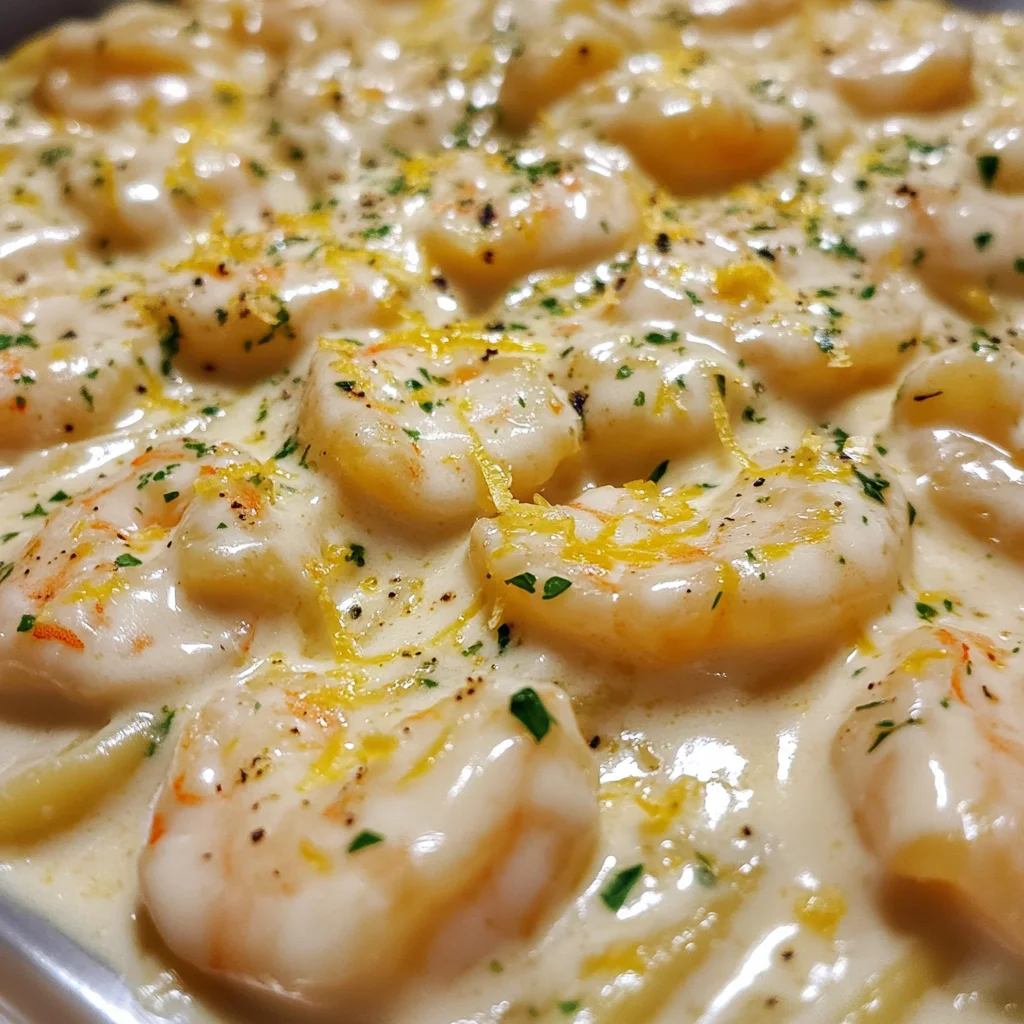Quick Overview
If you’re looking for a delightful dish that combines the richness of cream with the zesty freshness of lemon, then this creamy lemon shrimp pasta is perfect for you. This dish is not only quick to prepare but also bursts with flavorful ingredients that will impress your family or guests. In just under 30 minutes, you can whip up this satisfying meal that’s sure to become a favorite in your household.
Ingredient Breakdown
H4 Shrimp
For this recipe, you will need 1 pound of large shrimp, peeled and deveined. Fresh or frozen shrimp works well; just ensure that if using frozen, they are completely thawed before cooking. The shrimp adds protein and rich seafood flavor to the dish.
H4 Pasta
Use 8 ounces of fettuccine or linguine pasta for a hearty base. Cook it al dente according to package instructions. The pasta serves as an excellent vehicle for the creamy sauce and complements the tender shrimp beautifully.
H4 Heavy Cream
You will need 1 cup of heavy cream. This ingredient provides a rich and smooth texture to the sauce, making it creamy and indulgent. It’s crucial for achieving that luscious mouthfeel in your finished dish.
H4 Lemon Juice and Zest
Fresh juice from 1 medium lemon and its zest is essential for brightening up the flavors. The acidity cuts through the richness of the cream while adding a refreshing citrus note that elevates the entire dish.
H4 Garlic
Add 3 cloves of minced garlic for depth of flavor. Garlic enhances the overall taste with its aromatic qualities and pairs perfectly with both shrimp and lemon in this recipe.
H4 Parmesan Cheese
Grate ½ cup of fresh Parmesan cheese. This cheese contributes nuttiness and saltiness to the sauce while helping it to thicken slightly as it melts into the cream.
H4 Fresh Parsley
Chop about ¼ cup of fresh parsley for garnish. This herb not only adds a pop of color but also a fresh herbal note that balances out the richness of the cream.
Step By Step Recipe: Creamy Lemon Shrimp Pasta
H4 Cook the Pasta
Begin by bringing a large pot of salted water to a boil. Add 8 ounces of fettuccine or linguine to the pot once boiling. Cook according to package directions until al dente, usually about 8-10 minutes. Once cooked, reserve about half a cup of pasta water before draining thoroughly.
H4 Sauté Garlic and Shrimp
In a large skillet over medium heat, add two tablespoons of olive oil along with three minced garlic cloves. Sauté until fragrant but not browned, about 1 minute. Then add your pound of peeled and deveined shrimp to the skillet; cook until pink and opaque, which should take around 3-5 minutes.
H4 Prepare the Cream Sauce
Once your shrimp are cooked through, lower the heat slightly and pour in one cup of heavy cream along with juice from one medium lemon and its zest. Stir continuously for about two minutes until well combined. The heat will help thicken the sauce slightly.
H4 Mix in Cheese
Add half a cup of grated Parmesan cheese into your skillet while stirring continuously until it melts into the sauce completely. This step creates a creamy texture that clings beautifully to both the pasta and shrimp.
H4 Combine Pasta with Sauce
Gradually add your cooked pasta into the skillet along with reserved pasta water if necessary for consistency. Toss everything together until each strand is coated in that luscious sauce; this should take around two minutes on low heat.
H4 Garnish Before Serving
Finally, sprinkle freshly chopped parsley over your dish before serving. You can also add extra Parmesan on top if desired for an additional flavor boost. Serve immediately while warm!
Serving and Storing Tips
H4 Serving Suggestions
Serve your creamy lemon shrimp pasta immediately after preparation for optimal taste. Pair it with a side salad or some crusty bread to soak up any remaining sauce on your plate! A glass of white wine could complement this meal wonderfully as well.
H4 Storing Leftovers
If you have leftovers, store them in an airtight container in your refrigerator for up to three days. To reheat, gently warm on low heat on the stovetop or microwave until heated through without overcooking the shrimp again.
This creamy lemon shrimp pasta promises simplicity without sacrificing flavor—perfect for busy weeknights or special occasions alike!
Mistakes to avoid
One common mistake is overcooking the shrimp. Shrimp cooks quickly, so you should only sauté them for a few minutes until they turn pink and opaque. Overcooked shrimp can become rubbery and lose their delicate texture. It’s best to remove the shrimp from the heat as soon as they reach the right doneness.
Another mistake is neglecting to season your pasta water. Adding salt to boiling water enhances the pasta’s flavor significantly. Without this simple step, your creamy lemon shrimp pasta may come out bland. Use ample salt when boiling the water for the best results.
Failing to balance flavors is also a frequent error. The creamy sauce must have just the right amount of acidity from the lemon juice. Too much acid can overpower the dish, while too little can leave it tasting flat. Taste and adjust as you go to find that perfect balance.
Lastly, using low-quality ingredients will impact your dish’s overall flavor. Fresh shrimp, high-quality pasta, and real cream make a noticeable difference in taste and texture. Always opt for fresh ingredients whenever possible to elevate your creamy lemon shrimp pasta.
Tips and tricks
Using fresh shrimp is essential for achieving optimal flavor in your creamy lemon shrimp pasta. If you can, buy shrimp that has been recently caught or frozen immediately after being harvested. Fresh shrimp has a sweet, briny flavor that pairs beautifully with the zesty lemon sauce. When buying frozen shrimp, look for those labeled as “wild-caught” rather than farmed for better quality.
Cooking your pasta al dente is another crucial tip. This means cooking it until it’s firm but not hard. Al dente pasta holds up well when mixed with sauces and prevents it from becoming mushy in your creamy lemon shrimp pasta recipe. Remember to reserve some pasta cooking water before draining; it helps adjust sauce consistency later.
To amplify flavors without additional calories or fat, consider adding aromatics like minced garlic or shallots at the start of cooking your shrimp. They infuse the oil with flavor and enhance the overall dish without overwhelming it with richness.
Lastly, garnish your creamy lemon shrimp pasta with fresh herbs like parsley or basil before serving. This adds a burst of color and freshness that complements the dish nicely while providing an aromatic finish that pleases both the eye and palate.
Suggestions for Creamy Lemon Shrimp Pasta
Serve creamy lemon shrimp pasta with a side of garlic bread for a classic pairing that enhances any Italian meal. The buttery, garlicky bread complements the citrusy flavors of the dish while offering a satisfying crunch that contrasts with its creaminess.
Consider adding vegetables like spinach or cherry tomatoes to your recipe for added nutrition and color. These ingredients not only enhance visual appeal but also provide additional vitamins and minerals while balancing flavors beautifully in every bite.
For those looking to substitute gluten-free options, use gluten-free pasta instead of traditional wheat-based varieties in your creamy lemon shrimp pasta recipe. Many brands now offer delicious alternatives made from rice or chickpeas that maintain a great texture when cooked properly.
If you’re interested in variety, try adding different proteins such as chicken or scallops along with or instead of shrimp. Each option offers unique flavors that pair well with the creamy lemon sauce and allow you to customize this dish according to personal preferences.

FAQs
What type of shrimp should I use for creamy lemon shrimp pasta?
When choosing shrimp for creamy lemon shrimp pasta, opt for medium to large-sized varieties like Gulf or Argentinian pink shrimp known for their sweet flavor and firm texture. Fresh is ideal, but if unavailable, frozen wild-caught shrimp works well too—just ensure they’re peeled and deveined before cooking.
Can I make this dish ahead of time?
While it’s best served fresh due to its creamy sauce’s potential separation upon cooling, you can prepare components ahead of time. Cook the pasta al dente and store it separately from the sauce and cooked shrimp in airtight containers in refrigerate until ready to combine just before serving.
How can I make my sauce thicker?
To thicken your creamy lemon sauce without altering its flavor significantly, consider adding grated cheese like Parmesan or cream cheese gradually while stirring over low heat until melted into a smooth consistency. You can also mix cornstarch with cold water to create a slurry that thickens when heated gently.
Can I substitute cream in this recipe?
Yes! If you’re looking for lighter alternatives, consider using half-and-half or whole milk mixed with a bit of cornstarch as a thickening agent instead of heavy cream in your creamy lemon shrimp pasta recipe; however, keep in mind that this will change its richness slightly.
What can I serve alongside creamy lemon shrimp pasta?
Pairing salads such as arugula salad dressed lightly with olive oil and balsamic vinegar complements rich dishes like creamy lemon shrimp pasta beautifully by providing freshness and acidity on your plate without overwhelming other flavors present in this delightful meal.
How do I store leftovers?
To store leftover creamy lemon shrimp pasta safely, allow it to cool completely before transferring it into an airtight container; refrigerate leftovers promptly within two hours after cooking them up! Enjoy within 2-3 days by reheating gently on low heat—adding extra liquid if necessary—to restore its original creaminess!
Summary
In summary, creating delicious creamy lemon shrimp pasta requires attention to detail while avoiding common mistakes like overcooking seafood or neglecting seasoning choices during preparation stages! By implementing useful tips such as using fresh ingredients along with appropriate garnishing techniques will enhance overall enjoyment levels significantly! With these insights about storing leftovers properly too—your culinary journey around this delectable dish is sure-fire success!

